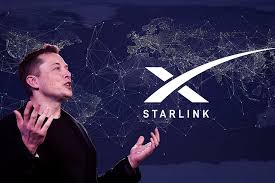Starlink, SpaceX’s ambitious satellite internet project, is set to revolutionize the way we access the internet globally. With its network of low-Earth orbit (LEO) satellites, Starlink aims to provide high-speed, low-latency internet connectivity to even the most remote and underserved areas of the world, without relying on traditional undersea cables.
How Starlink’s Satellite Network Works
Starlink’s network consists of thousands of small satellites orbiting at an altitude of around 550 kilometers. These satellites work together to create a large satellite constellation, providing global coverage. Unlike traditional geostationary satellites, Starlink’s LEO satellites have a much lower orbit, reducing latency and improving internet speeds
Users access the Starlink network through a small, flat user terminal, also known as a “dish” or “antenna.” This terminal is equipped with phased array technology, allowing it to automatically adjust its position to connect with the optimal satellites.Once the dish is installed and connected to the user’s home network, it can provide high-speed internet access without the need for traditional infrastructure like cables or cell towers.
Starlink’s recent upgrade to its satellites includes the incorporation of an Evolved Node B (eNodeB) modem, which functions similarly to a cellphone tower but is located in space. This is how Starlink will seamlessly integrate with Kenya’s cellular networks that currently rely on undersea cables for internet connectivity.
Let’s explore how this innovative technology works, from the moment you hit “send” to when your recipient receives your message.
1. User Initiation
Imagine you’re on your smartphone, ready to send a message or make a call. This device serves as your communication hub, allowing you to connect with others instantly. With Starlink, this process is about to get even more exciting.
2. Data Encoding
Once you initiate the action, your message is encoded into a digital format. For text messages, this means converting your words into binary code. If you’re making a voice call, the analog sound waves are digitized, transforming your voice into data that can be transmitted over the internet.
3. Local Network Transmission
Next, your encoded data travels from your device to the Starlink user terminal, commonly known as a “dish.” This sleek terminal connects to the Starlink network and features a phased array antenna that automatically aligns itself to communicate with the satellites orbiting overhead.
4. Satellite Communication
Once your data reaches the Starlink dish, it’s sent to the nearest Starlink satellite in low Earth orbit (LEO). These satellites operate at an altitude of about 550 kilometers, allowing for low latency and high-speed data transmission. The satellite receives your data and relays it to a ground station.
5. Ground Station Routing
The ground station plays a crucial role in directing your data toward its destination. It can either send your message to another user on the Starlink network or route it to the broader internet if your recipient is using a different service provider.
What happens if you are using the internet?
If your recipient is on the internet, your data packets travel through various routers and switches across the network to reach their destination. If they’re also using Starlink, the data will be sent back through the satellite network to their dish.
As your data packets arrive at the recipient’s device, they are processed by the device’s network interface card (NIC). This component converts the incoming packets back into a readable format, allowing the recipient to view your message or hear your call.
Once received, the recipient’s device decodes the data, making your message or call available for interaction. For text messages, this means displaying the text; for voice calls, it involves converting the digital signals back into audio.
If the recipient wants to respond, the process reverses. Their device encodes the response, sending it back through the Starlink satellite network or the terrestrial internet, following the same path until it reaches you.
Starlink’s satellite network is set to transform customer care, making it more accessible and efficient than ever. With its global reach and low-latency, even customers in remote areas can easily connect with support through voice, video, or messaging. The reduced lag will enable real-time interactions, ensuring prompt issue resolution.
Starlink’s integration with cellular networks will further streamline the experience, letting customers choose their preferred communication method for a tailored support experience.
Beyond enhancing accessibility and responsiveness, Starlink’s reliable high-speed will empower remote troubleshooting and support, reducing the need for in-person visits and improving overall efficiency.
As Starlink continues to shape global connectivity, customer care will evolve, delivering a seamless, customer-centric experience. Help will be just a click away, no matter where you are.


















+ There are no comments
Add yours